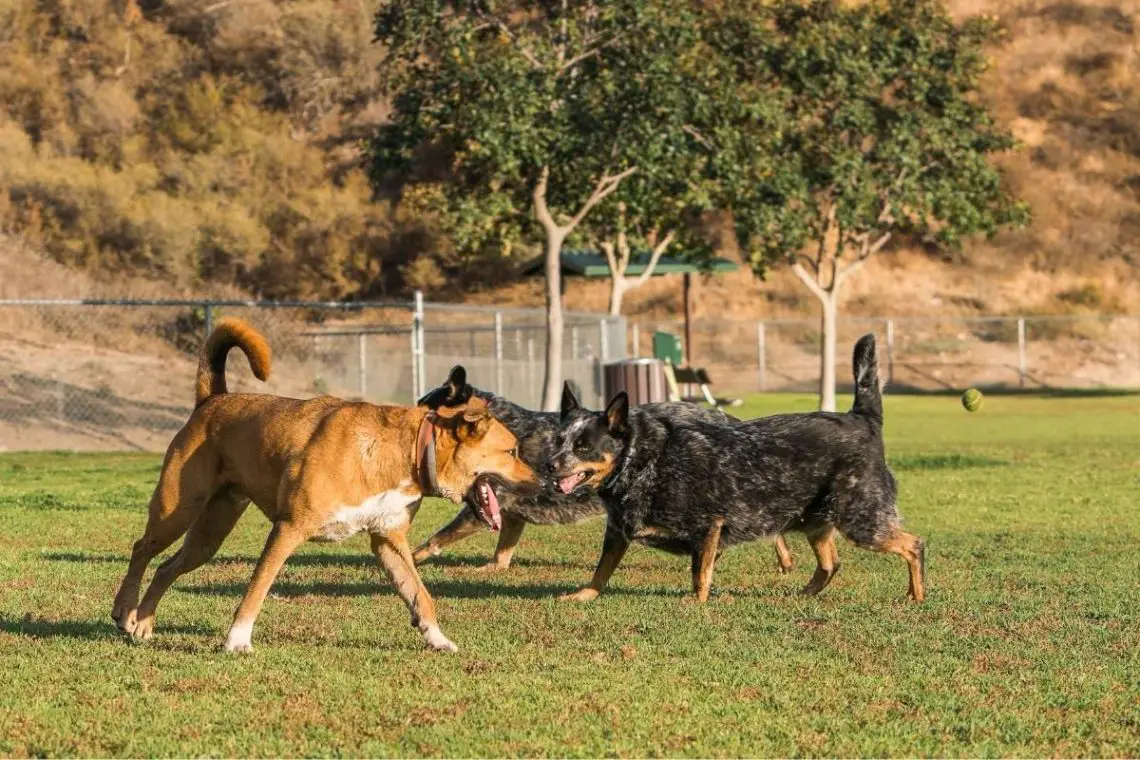Dog parks are a popular way for people to exercise their energetic dogs and visit with other dog lovers. However, there are numerous articles on the internet that discourage people from doing this and advise of the dangers that you may encounter at the dog park.
We will explore some of the benefits of visiting dog parks, as well as the negative aspects and how to minimize those. We will also go through some of the alternatives to dog parks that you might find better for your particular dog!
Table of Contents
What is Good About a Dog Park?
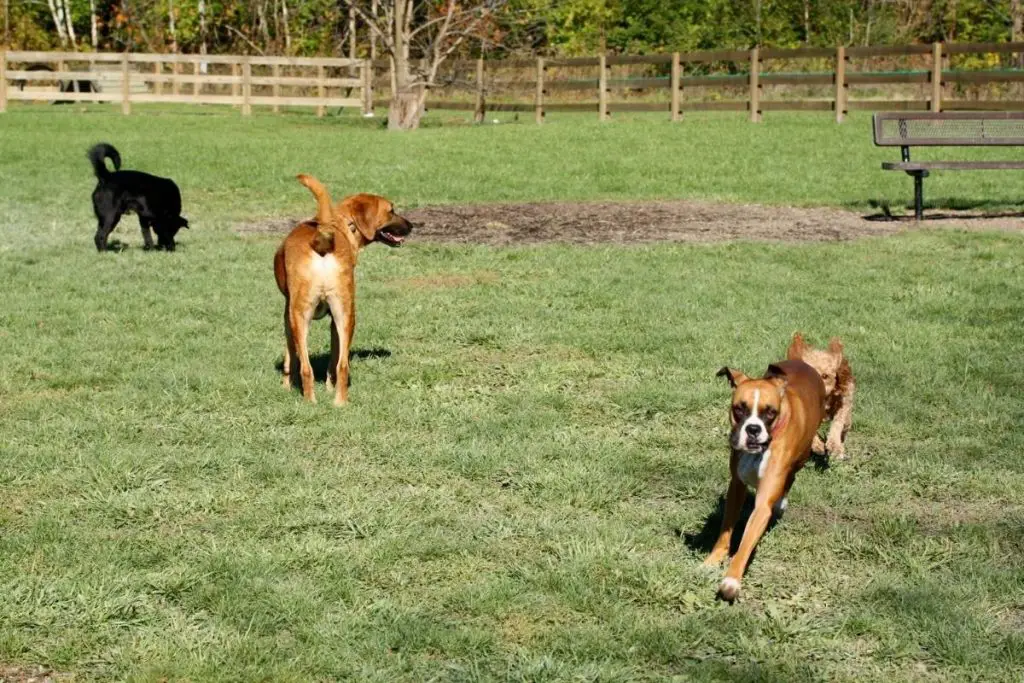
A dog park is a large, fenced-in, safe area with numerous dogs running and playing together off-leash while their owners relax and watch their dogs have the time of their life. Sounds great, right? If it always went perfectly, it would be great! And there are some fantastic benefits for dogs and their owners when dog parks work well!
Exercise for your Dog
It’s no secret, dogs need exercise. This can be achieved by LONG walks or daily jogs with our dogs, but for those of us not that keen on spending an hour walking around our neighborhood each day, or those that prefer to only run when chased by zombies, a dog park can be a great alternative! Being able to run at full speed in a large area is something many dogs enjoy immensely.
While some people are lucky enough to have a yard large enough for their dogs to RUN in, many dog owners have small yards or live in apartments with no yards. An enclosed dog park offers an excellent opportunity for exercise if you have a dog that will run on their own, enjoys running with other dogs, or will chase a ball.
Playtime with Other Dogs
If your dog enjoys playing with other dogs, a well-run dog park can offer a wonderful opportunity for this! Of course, there are many precautions that must be taken (see below), but if you are lucky enough to have a dog that gets along great with new dogs, a dog park is a perfect opportunity for them to meet and play with lots of doggy friends!
Human Socialization
Where there are dogs, there are “dog people.” A dog park is no exception to this! Spending a couple of hours surrounded by dogs and the people who love them can be an excellent activity for humans as well as dogs. It can also be a great way to network and share information about your favorite pet products, trainers, and veterinarians.
What Is Bad About a Dog Park?
Unfortunately, in most cases, the cons of a dog park far outweigh the pros. Of course, this is heavily dependent upon the actual park, the location, and the dogs (and their owners) that frequent the park. However, before you venture out to the dog park with your four-legged best friend, you must look at the dangers associated with going.
Dog Fights
While it’s true that dogs are naturally a social species, placing a bunch of random dogs together in a fenced-in area is not a naturally occurring phenomenon. There are bound to be different play styles, training levels, and types of dogs there, which is often a recipe for dog fights.
Add to that a bunch of owners that often think their perfect little Fluffy can do no wrong, and it’s no surprise that altercations happen quite often. While there are ways to lessen the chance of fights, it’s a danger that you must take into consideration every time you walk into a dog park with your pet.
Injuries
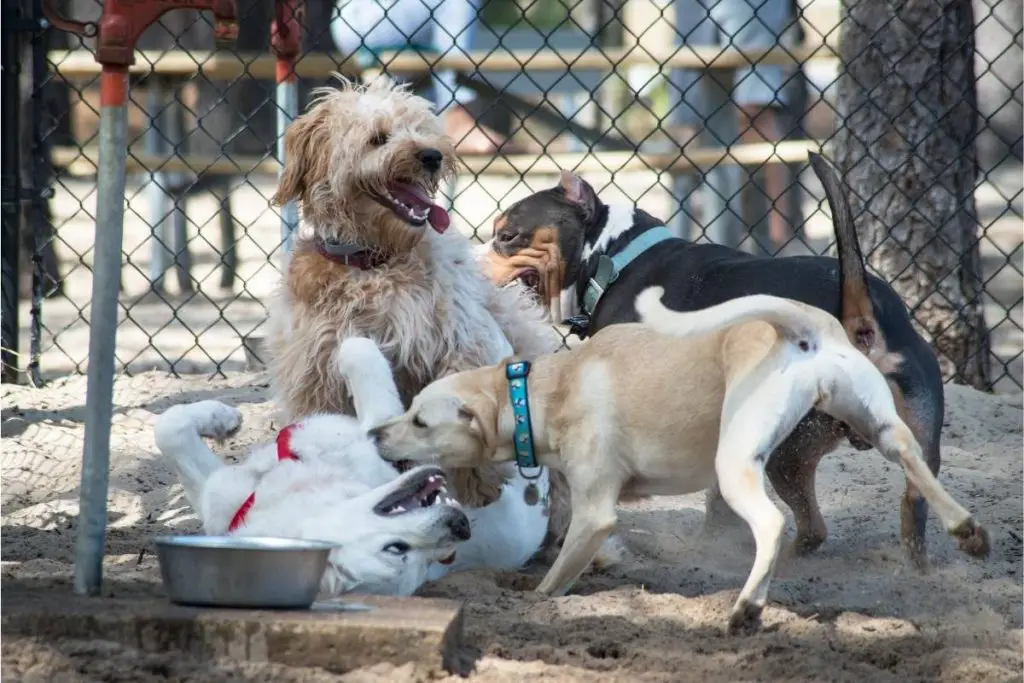
Whether they come from a dog fight or too much rough-housing, injuries are also common at dog parks. The added danger to injuries at the dog park includes the fact that an injured dog will often yelp or scream, which can easily excite nearby dogs and result in a dog fight or other dogs ganging up on the injured dog.
Having a first aid kit nearby is a must, as is knowing where the nearest emergency animal clinic is located. This is especially important since many people frequent dog parks after work or on weekends when many regular vet clinics are closed.
Diseases
Public dog parks almost always have signs posted that require all dogs entering to be healthy, free of parasites, and current on their vaccinations. However, rarely (if ever) is there anyone monitoring that and requiring any sort of veterinary proof. Not to mention the fact that many people are irresponsible and do not promptly clean up their dogs’ poop.
Anytime you enter a dog park, you are definitely putting your dog at risk for diseases and parasites. Thankfully, most dogs have immune systems that are equipped to deal with this risk, but not all do.
Bad Habits
Training in a dog park is nearly impossible. It is STRONGLY recommended that your dog be off-leash while inside the park (one leashed dog in a sea of unleashed dogs is often a recipe for a disaster). And, most parks also post that no treats or food are allowed in the park. This can make convincing your dog to do as they are asked incredibly challenging.
Therefore, it gives them a perfect opportunity to develop bad habits, like not listening to you. There are also many times where your dog will be far enough away from you that you will not be able to enforce your rules, such as not jumping up on people.
Is Your Dog a Good Dog Park Candidate?
If you have read the pros and cons and feel that a dog park still might be a good thing to try out, you now need to decide if your dog is a good candidate for dog park play.
Consider the Breed and Size of your Dog
While there are exceptions to every breed stereotype, it’s important to remember that each breed has a written standard that describes what the “perfect” example of that breed is. Part of this breed standard includes information on their behavior and temperament.
It is essential to consider their temperament when deciding if your dog is a dog that should visit a dog park. For instance, many hound breeds were bred to hunt as a pack and may do better in a group of dogs than some working breeds that were bred to work alone and might be prone to dog aggression.
Many dog parks offer separate sections for large and small dogs. This is for your dog’s safety. Even a large dog that is very friendly might injure a little dog while playing. While there might be exceptions (for example, a large dog that is very passive and calm or a small dog that is feisty and full of energy), it is generally best to keep your dog in the area of the park designated for their size.
How Old is your Dog?
Most dog parks require puppies to be at least 4 months old and fully vaccinated before entering the park. However, just because your pup is technically allowed to be there, doesn’t mean it’s a good idea.
Not all dogs behave appropriately with puppies, and a bad experience with another dog at that age can have a long-lasting impact on a puppy.
On the other hand, your senior dog might not be up for a game of chase or rough-housing with energetic dogs. He might much prefer a quiet walk around the neighborhood with his favorite human companion.
In general, dog parks work best for young adult dogs that are in good health, already well-socialized, and enjoy being extremely active with other dogs.
What is your Dog’s Energy Level?
Most of the time, dog parks work best for dogs with high energy, but not extreme energy. A dog that likes to play chase or fetch a ball will often enjoy the open space and companionship of other dogs that a dog park offers. However, an extremely hyper dog can sometimes draw negative attention from other dogs, especially from some working and herding breeds that tend to prefer situations more organized and under control (sometimes affectionately referred to as the “fun-police” dogs).
What is your Dog’s Temperament?
Perhaps the most important thing to ask before taking your dog to a dog park is if he or she has the right temperament to be there. If your dog is overly pushy with other dogs or dominant in their play, a dog park is not the best environment for them. Fearful dogs will not enjoy being overwhelmed at a dog park, and taking them can often increase their fearfulness. If your dog has a tendency to resource guard toys (or humans!), a dog park can be disastrous. Dogs that seem themselves as the “fun-police” might also get themselves in some trouble in a dog park situation.
If your dog fits any of those temperament descriptions, you would be better off checking out some of the alternatives to dog parks that we will discuss later in this article.
Is Your Dog Intact or Spayed/Neutered?
While all dog parks do have a rule that no female dogs in heat are allowed, if your dog is intact, you might want to think carefully about using a dog park. Not all people are as aware of their dogs as they should be, and having an intact male or female dog in the park does present some potential issues that need to be carefully considered. Constant supervision of your dog is a MUST at any dog park, but this becomes even more crucial if there are in-tact dogs present.
How Do I Choose a Dog Park?
Not all dog parks are created equal, and your experience at the park is dependent on the quality of the park you choose. Here are a few things to consider when choosing a dog park to visit.
Size of the Dog Park
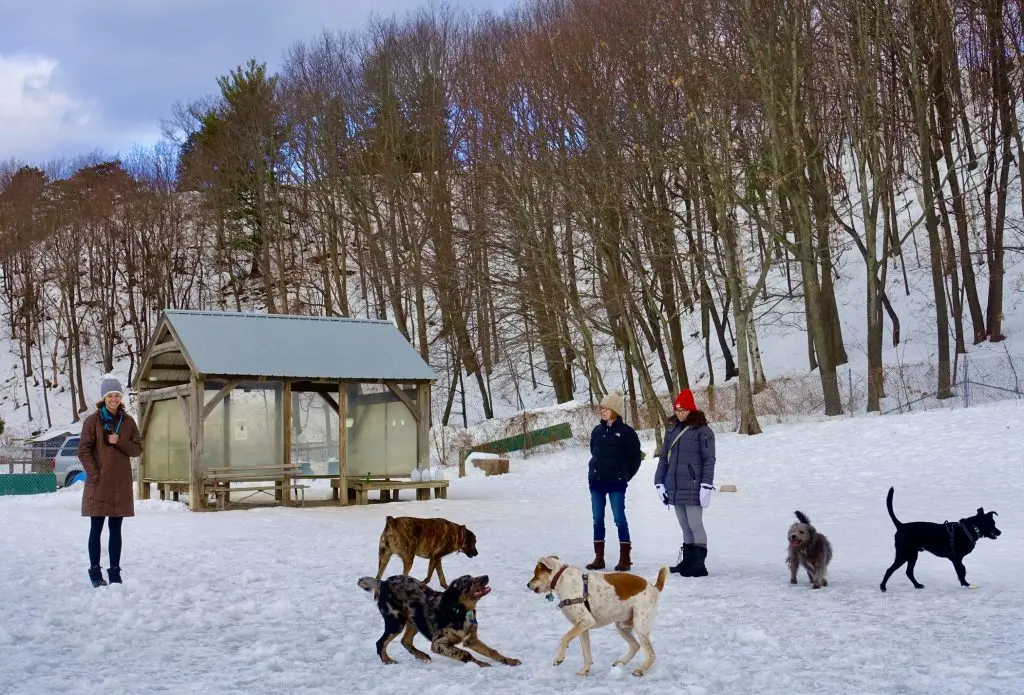
Generally, the larger the dog park, the better. More space means more room to run and fewer chances of the dogs becoming possessive of their area. However, a larger park means that you need to walk more to supervise your dog to make sure no issues arise. Should tension increase between dogs, you need to be close enough to redirect your dog to a more appropriate activity. The other drawback to a large park is that people often get lazy about cleaning up after their dogs, as they may not see their dogs relieve themselves.
How Clean is the Dog Park?
The cleanliness of a park should be something you take into consideration when choosing a dog park. While all parks require owners to pick up after their dogs, some seem to do a better job making that happen. A dog park with staff that regularly empties trash cans, cleans water dishes, and refills poop-bag dispensers will often attract owners that are better at picking up after their dogs.
Dog Park Rules and Requirements
Most dog parks have a set of regulations requiring such things as dogs to be at least 4 months old, vaccinated, non-aggressive, and females not to be in season. It’s important to familiarize yourself with the rules of the park you are considering. Some dog parks, especially private dog parks within homeowners’ associations, may have other rules and regulations as well. Some even require owners to apply for a dog park membership before visiting the park. Generally, the more rules, the safer the dog park experience will be for you and your pet.
How Closely is the Dog Park Monitored?
The majority of dog parks are not staffed. This means it is up to the dog owners to enforce the rules of the park among themselves.
Obviously, this can cause problems sometimes. If you can find a dog park in your area with a park ranger or other staff member assigned to monitor the park, you are likely to have a better experience there with your dog.
People and Dogs that Frequent the Dog Park and Time of Day
Humans tend to be creatures of habit, so many times if you go to the dog park at the same time of day (or on the same day of the week), you will likely encounter the same people and dogs.
This can be beneficial if you can find a group of dogs that play well together and humans who carefully supervise their dogs. On the other hand, if you have a poor experience at a park, you might want to try going at a different time before giving up on the park altogether.
What Are Some Alternatives to Dog Parks?
If you have decided that your dog is not a good dog park candidate or are just not willing to take the risks that are always associated with off-leash play in dog parks, don’t worry! There are alternatives to dog parks that will still allow your dog to get exercise and socialization!
Doggy-Daycare
Doggy-daycares have become a popular alternative to dog parks. A properly-run daycare can remove many risks associated with public dog parks, while still maintaining most of the benefits. Many daycares offer indoor and outdoor play areas, which can be very beneficial in areas with extreme weather conditions.
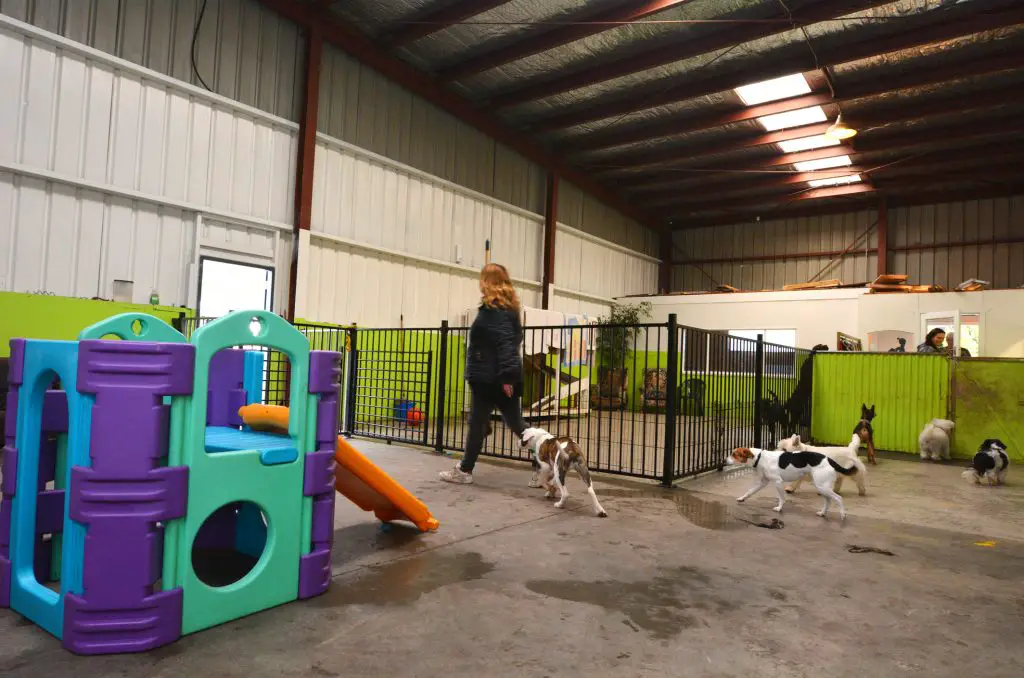
Of course, you will want to research the daycares in your area before deciding on the one you want to take your dog to. Keep in mind the same things mentioned above when searching for a dog park, especially size, cleanliness, rules, and monitoring.
The benefit of a daycare facility is that there is control over which dogs can attend. This means that your dog can be matched up with dogs of a similar size and play-style, therefore increasing the chance of a successful experience. A good daycare will require an interview of some sort as well as veterinary records before allowing your dog to participate. Many will also schedule a short trial run (often free or at a reduced rate) before accepting your dog into their facility.
Make sure the daycare has enough knowledgeable staff to monitor all of the play sessions. They also need to keep the areas the dogs are in very clean throughout the day. Separate play areas for different sized dogs and different energy levels is a big plus, as are separate “time-out” areas for dogs that might need a little bit of down-time by themselves to relax throughout the day.
A distinct drawback to a daycare versus a public dog park is going to be the cost. A full day of daycare from a commercial dog daycare facility can range from $20-40 depending on the facility and location. Most daycares offer a reduced price when you purchase a package of several days. An alternative that is sometimes less expensive would be a daycare program ran out of someone’s home. However, regulations might not be as strictly adhered to in that case, so you will need to research carefully!
Another drawback to daycare for some people is that most daycares require all dogs over six months old to be spayed or neutered before participating. This presents a challenge for owners who prefer to keep their dogs intact, whether for showing or health purposes.
Private Dog Playgroups
If you have nearby friends with dogs of a similar age and play-style, a private playgroup is an excellent alternative to a public dog park, and cheaper than a daycare! Arranging for your pup to spend the day at a friend’s house can be a great way to get in some exercise and socialization in a safe, controlled way.
Of course, the challenge with this alternative is finding dogs that fit well in the playgroup and that have owners willing to participate! Check with your neighbors and speak with other dog owners you see out on your walks to see if there are others in your area interested in getting together for some doggy playgroups. You can also talk with your veterinarian and your dog trainer; they may know of others in the same situation as you that might make great playgroup participants!
Training Classes
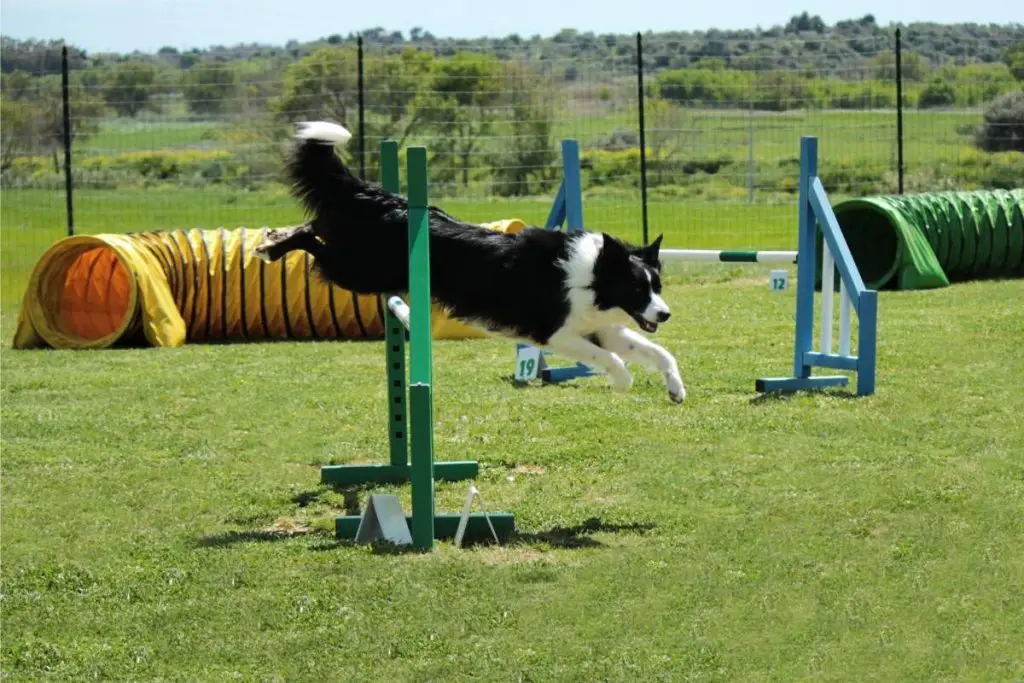
While not an exact alternative to a dog park, training classes can be an excellent way to offer your dog mental stimulation (as well as a little physical activity) and socialization with other dogs and people. There are classes available in everything from basic obedience to agility and dock-diving, and everything in between. And, as I mentioned before, the dogs you meet in training class might end up being great playgroup friends for your dog!
Individual Exercise
The alternative that most people opt for when they choose not to visit dog parks is individual exercise.
This could be a walk around the neighborhood, a trip to the park, or a run along beside your bike or scooter. A game of fetch in the backyard works well for many dogs, and if you are lucky enough to have a pool and a dog that likes to swim, swimming can be an excellent way to exercise your pooch in those hot summer months!
Taking the same 20-minute walk around the same block every day is not usually enough for a high-energy dog. Instead, try varying your individual exercise routine by taking a different route or visiting a different park. Biking one day and walking the next day can also add variation to your routine and meet your dog’s physical and mental exercise requirements.
SniffSpot
SniffSpot is a perfect substitute for dog parks! SniffSpot has an app that you can download to your phone and it’s basically a yard rental program, similar to Airbnb. But, instead of renting a home for a weekend, you rent a yard for an hour for your dog to play in.
The program was started in Seattle, WA, by David Adams in 2018, and has since grown to offer SniffSpots throughout North America and even a few other countries. Renting a yard through the app gives you an opportunity to let your dog run in a safe, fenced area without the risk of encountering unknown other dogs. Pure Dog Talk recently did a podcast interview with David that goes into even more detail about this great alternative to dog parks.
SniffSpot hosts post information about their yard on the app, which allows you to choose the best environment for your dog. Some of the spots even have pools that let you swim with your dog!
I’ve personally taken my own dogs to several SniffSpots, and my dogs always have a great time! The spots also present a great training opportunity, as they allow you to work with your dog off-leash around the distraction of a new environment without the dangers of taking your dog off-leash in an un-fenced park.

You can even schedule a SniffSpot with a friend and their dogs – this will give you a similar experience to the playgroups mentioned above, but with more space to run!
If you are lucky enough to have a perfect dog yard of your own, you might want to become a SniffSpot host. Hosts can earn up to $1000/mo by offering their dog-friendly yard to other pet-lovers!
Conclusion
Now that you have had a chance to weigh the pros and cons of dog parks, as well as take a look at some of the other alternatives to dog parks that are available, you can make an educated decision as to whether a dog park is the best choice for your dog.
If you have a dog that fits the profile of a good dog park candidate, and you have clean, safe dog parks near you, they can be a great experience! And, if you have found some great dog parks in your area, or other interesting alternatives to dog parks, please share them with us in the comments below!
However, please keep safety in mind at all times regardless of the exercise option you choose for your dog. Most importantly, remember to be a responsible dog owner – supervise your dog at all times, and be sure to clean up after your dog! Have a great time exercising your dog, whichever option you choose!

